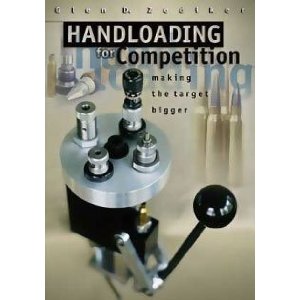In another post, I suggested the Lyman Reloading Handbook for beginner to intermediate bullet reloaders. But what if you’re looking for something a little more advance? If you’re already a competent reloader, and looking to increase accuracy of your rounds, I would suggest looking into Handloading for Competition by Glen D. Zediker
It has more information than I’ll probably ever get the time to post here.

Handloading for Competition is just what its title says – for precision handloaders, not bulk loaders looking to reload 500 bullets in an evening. This is an important distinction as it will make more sense as you read on.
The book isn’t very big, but is very information dense and packed full of good quality information. Two things stand out to me which I’ll describe in detail later: the equipment analysis and the how-to data on technique covering everything from the reloading tasks themselves to load development and analysis. These are of course topics that go hand-in-hand, as Zediker talks about finding the right tool for the right job as he proceeds to describe what the ‘right job’ really is.

If there’s a central idea for what qualifies as good gear in the author’s mind, I’d dare to say it goes something like this – if it’s measuring equipment it needs to produce reliable and consistent numbers. If it’s fabrication equipment, it needs to produce accurate and repeatable results, with bonus points for efficiency of motion. So for example, you’ll see him advocate the use of Stoney Point (now Hornady) headspace gauges for use with a caliper rather than the type of hand held enclosures that rely simply on visual appearance. Again, the reliance on measurable data is a theme for each step. It’s through the quality measurement tools and the how to use them that he measures the effectiveness of the fabrication tools like trimmers, presses, scales, dies, etc.
The book stresses theory, as he thinks through with the reader why a particular technique is a good. He also recommends practice as should be used with any new technique. Many times this reasoning refers known good practice used by those who win at competitions, and why this is a good line of reasoning. At the same time the author is careful to point out techniques that people in benchrest competition do that don’t work for people in highpower competition. Similarly, there are often the qualifying remarks for people who don’t care about competition at all, albeit with some sarcasm. I think these statements improve the relevancy to an audience that may not actually compete.
Certainly there are folks interested in precision reloading of bullets that are not members of the CMP or any organized competitive group. Many people are interested in the science of what they’re doing or are just pursuing the state of the art. How do you improve the consistency with which you are seating bullets? How do you determine how far off the lands of the barrel the bullet should sit, and thus how much ‘jump’ the bullet has? Some people ‘do what they do’ and never worry about why or how they arrived at a certain decision. If you are the kind of person that wonders about the logic behind what you do, this is the book wholeheartedly recommended for you.